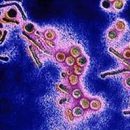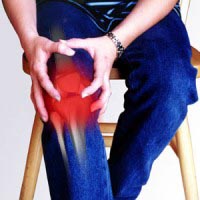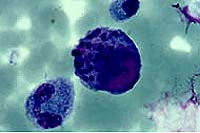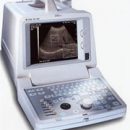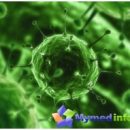Pregnancy is a serious test for the body of a woman. Often, precisely during this period, chronic diseases are exacerbated, immunity decreases and therefore the future mother becomes especially vulnerable to any kind of infectious diseases.
Content
When the future mother first comes to women's consultation, the doctor may ask if the family should appear in the family, a cat. This is not idle curiosity: it is the cats most often become a source of infection with toxoplasmosis - a disease that represents a serious danger to the health of a non-born child. Of course, it is not at all necessary to give your favorite «in good hands» - We just need to know about those precaution measures that will help a pregnant woman to avoid disease.
Toxoplasmosis is a disease caused by intracellular protozoa microorganisms toxoplasma gondii, which are found everywhere and affect herbivores, carnivorous and omnivorous animals, as well as birds and reptiles. Acquired toxoplasmosis in adults often proceeds in the latent (hidden) form. In acute form, the brain, eyes, lymphatic system, liver, spleen, heart and other organs can be affected.
Toxoplasmosis infection
Toxoplasms exist in three forms:
- free parasites (tachiesoites);
- cysts (forms of microorganism protected by a dense shell and very resistant to external influences);
- Oocysts (this form of parasite can be detected only in Feline Frequach Faces).
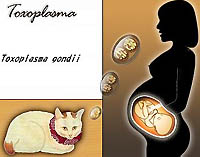 Cysts are formed in the body of animals from the free form of parasites and are preserved in this form in various tissues and organs. When using contaminated meat of animals (sheep, pigs, game, etc.) human infection occurs.
Cysts are formed in the body of animals from the free form of parasites and are preserved in this form in various tissues and organs. When using contaminated meat of animals (sheep, pigs, game, etc.) human infection occurs.
Oocysts are formed from the free form of parasites and from cyst only in the intestinal cells of representatives of the Feline family and then stand out with their feces. Cat selection period Oocyst is 7-20 days, and during the day one cat allocates up to 10 million parasites. After primary infection, animals develop immunity, protecting them from re-infection. To acquire infectious properties, oocysts undergo a number of changes; This occurs in an external environment at a temperature of 4-37O (optimal temperature - 24O) within 2-3 days. In warm damp soil, they retain their infectious properties for more than a year. The human infection occurs when contacting any material contaminated by the faeces of infected cats, for example, if you smoke the cat, care for it, and also in contact with soil or sand infected with feces.
The view is about the fact that the toxoplasmosis carriers can be not only cats, but also dogs. This is not: in the body of the toxoplasms do not multiply.
Thus, the contamination of a person occurs by swallowing cysts or oocyst, as well as when transfusion of infected blood and transplantation of infected organs. Pregnant women through the placenta may be affected by the fruit.
Manifestations of disease toxoplasmosis
In the gastrointestinal tract of a person from a cyst or oocyst, parasites are distinguished, which fall into the cells of the gastrointestinal organs of the intestinal tract. There they multiply, after which they cause the gap of the cells and penetrate into neighboring cells. Then the causative agents of the disease fall into the blood and spread throughout the body, hitting any organs and fabrics (lymph nodes, eyes, brain, heart, lungs, kidneys, pancreas, skeletal muscles). The disease is manifested by an increase in and painfulness of various groups of lymph nodes, an increase in temperature, headache, violation of consciousness, pain in muscles and joints, rash, increased liver and spleen, signs of defeat of other internal organs.
A healthy person in response to the introduction of infection develops an adequate immune response, and free parasites are removed from the tissues. However, in the form of a cystic in a special protective shell, they can be maintained in the body throughout the life of the owner and cause repeated infection. In the oppression of immune infection, the infection is not contained by cells of the immune system, but continues to spread, causing acute inflammation of the brain tissue, lungs, hearts, which, in turn, can lead to a fatal outcome.
What is dangerous toxoplasmosis during pregnancy?
If the infection of a woman toxoplasmosis occurs during pregnancy, the causative agents of the disease can be transferred to the fetus. True, it happens infrequently. If the toxoplasm is still infected with the baby, pregnancy can end with spontaneous abortion, stillbirth, premature childbirth or birth in the term of an infected child. Congenital infection develops approximately 30% of children. In children born from mothers infected in the first trimester of pregnancy, congenital toxoplasmosis occurs in 17% of cases and occurs difficult enough. When infected in the third trimester of pregnancy, the disease is observed in 65% of children, but in this case it proceeds asymptomatic. The manifestations of congenital toxoplasmosis are different: this is an increase in body temperature, disruption of appetite, rash, generalized lymphadenopathy (increase of several groups of lymph nodes), increase in liver and spleen, jaundice, hydrocephalus, microftralmia (small eyeball size) and cramps. Intracerebral lesions and chorioretinite (inflammation of the vascular shell of the eye and retina) can be detected by the time of the birth of a child, but often appear later.
The degree of risk of infection of the fetus does not depend on the severity of the infectious process in the mother. If a woman has become infected with toxoplasmosis of more than 6 months before pregnancy, it cannot convey the child's infection. When the infection occurs in less than 6 months, the risk of transmission of infection is insignificant, but in rare cases it still happens.
Diagnosis and treatment of toxoplasmosis
Grounds for diagnosis «Toxoplasmosis» are: the release of toxoplasm from the blood, detection of causative agents of the disease in organs, the results of laboratory tests - the detection of antibodies to the toxoplasmas. The detection of free parasites in the blood and tissues indicates an acute stage of infection, the identification of the cyst is not proof of acute infection, since the latter can be maintained in tissues for a long time.
Since the direct allocation of toxoplasm is a rather time-consuming process, in practice, the study of antibodies in the blood is more often applied. IGM class antibodies are detected for the diagnosis of acute toxoplasmosis, as they appear in the blood after 5 days after infection, their level is quick and significantly increasing, and then decreases or disappears within a few weeks or months. IgG class antibodies are detected after 1-2 weeks after infection. After 6-8 weeks, their number is gradually decreasing, but in a small amount they preserve the antibody never indicates the severity of the disease.
Each woman planning pregnancy needs to determine the level of antibodies to toxoplasmas in order to identify infection.
If, according to the results of the analysis, you suspected primary infection with toxoplasmosis, then you need to consult in an infectious hospital or at a specialist in the treatment and study of toxoplasmosis. There you will be offered to pass the tests re-in 2-3 weeks.
During the examination of pregnant women, it is difficult to determine whether infection has occurred before or after conception and, accordingly, is infected with the fruit. An additional method for diagnosing a disease in pregnant women can serve the identification of toxoplasm in the oilyotic waters. When infected with toxoplasmosis in the first trimester, due to the high probability of severe fetal lesions, it is recommended either a pregnancy interruption, or early conducting specific treatment, as a result of which the risk of congenital infection in the fetus is significantly reduced, but it is not completely excluded.
Prevention measures of toxoplasmosis
Compliance with prevention measures is especially important for patients with immunodeficiency and for those patients who have not been detected by antibodies to toxoplasmosis, i.e., there were no contact with this causative agent. To destroy cyst meat, it is necessary to warm up to 60 OWith after cooking from raw meat, your hands should be carefully soaked, you can not try raw meat minced meat. The products listed above must necessarily be undergoing heat treatment, and fruits and vegetables that can be infected with oocysts, it is necessary to wash carefully. Pregnant women should avoid contact with cat excrement.
The effective toxoplasmosis vaccine does not exist, so compliance with the elementary hygiene rules today is the main method of preventing this disease.


